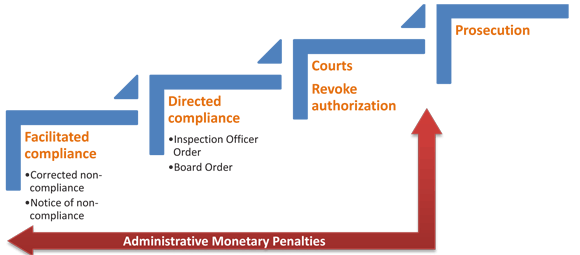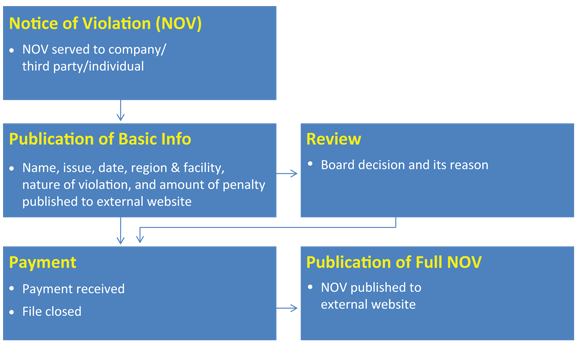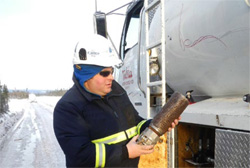ARCHIVED – Administrative Monetary Penalties Process Guide
This page has been archived on the Web
Information identified as archived is provided for reference, research or recordkeeping purposes. It is not subject to the Government of Canada Web Standards and has not been altered or updated since it was archived. Please contact us to request a format other than those available.
Administrative Monetary Penalties Process Guide [PDF 5212 KB]
Copyright/Permission to Reproduce
Table of Contents
- 1.0 Purpose
- 2.0 Background
- 3.0 NEB Enforcement Policy and AMPs
- 4.0 Regulations
- 5.0 The AMP Process
- 6.0 Contact Information
- 7.0 Abbreviations
1.0 Purpose

The National Energy Board (NEB or Board) is an independent federal agency responsible for regulating pipelines, energy development and trade in the Canadian public interest. The NEB regulates approximately 71,000 kilometers of pipelines across Canada. Under the National Energy Board Act (NEB Act) and its regulations, the Board promotes safety and security, environmental protection and efficient energy infrastructure markets.
This Administrative Monetary Penalties Process Guide (AMP Process Guide) sets out the key elements of the NEB’s administrative monetary penalties process (AMP Process) from initiating an AMP through to the review and final decision stages of the process.
2.0 Background

Administrative Monetary Penalties (AMPs) are financial penalties imposed by a regulatory body in response to contravention of legislative requirements. AMPs provide regulatory agencies with a flexible enforcement tool to complement other types of regulatory sanctions such as notices of non-compliance, orders, directions, and prosecution.
The Jobs, Growth and Long-term Prosperity Act, portions of which came into force on 6 July 2012, included changes to a number of pieces of legislation including the NEB Act. As part of these changes, new provisions were added to the NEB Act (sections 134 to 154) that establish a system of AMPs to promote compliance with the NEB Act. The NEB developed Administrative Monetary Penalties Regulations (AMP Regulations) allowing the Board to impose financial penalties on companies or individuals for non-compliance with the NEB Act, regulations, decisions, permits, orders, licenses or certificate conditions.
Details regarding AMPs are provided in the NEB Act and the AMP Regulations.
AMPs and the AMP Regulations are relevant to facilities regulated under the NEB Act and the companies and individuals who live and work in proximity to or with these facilities; they do not apply to NEB-regulated facilities and activities under the Canada Oil and Gas Operations Act.
3.0 NEB Enforcement Policy and AMPs
The NEB holds those it regulates accountable for safety, security and environmental protection outcomes using a rigorous compliance monitoring program and by enforcing legislative requirements.
Enforcement actions are the mechanisms used by the NEB to bring regulated entities or activities back into compliance with the NEB’s Acts and Regulations, to deter future non-compliance and/or to prevent harm.
The NEB’s objectives for enforcement actions are to achieve compliance as quickly and as effectively as possible. Achieving compliance reduces hazards and protects the safety of workers and the public, the environment and property. The NEB’s guiding enforcement policy statement is the following:
- The NEB will enforce regulatory requirements to obtain compliance, deter future non-compliance, and prevent harm by using the most appropriate tool or tools available.
The NEB will carry out enforcement actions in a manner that is fair, predictable and consistent. AMPs are not replacing any of the NEB’s current enforcement tools. The addition of AMPs has provided a new tool that may be used to address violations with the AMP Regulations.
Staff will continue to apply the most appropriate enforcement tool required to achieve compliance. The diagram below presents the NEB’s approach in using enforcement tools with an emphasis of escalation of enforcement from facilitated to directed compliance actions. As illustrated below, the AMP could be used in conjunction with any other enforcement tool, when appropriate.
Diagram 1: NEB Enforcement tools

More information about the NEB’s current enforcement tools can be found at the NEB website: www.neb-one.gc.ca.
The NEB will apply the following criteria to guide the use of AMPs:
- when compliance is not obtained using either facilitated or directed enforcement tools, or
- when harm is caused because of the non-compliance, or
- when harm would likely occur because of the non-compliance, or
- any other situation where an AMP is the best way to obtain compliance or deter future non-compliance.
For added clarity, the NEB’s existing Compliance and Enforcement for Damage Prevention model remains in effect and the enforcement tools described in the link above are available to respond to non-compliances, as appropriate.
Compliance to Orders, Decisions, Terms and Conditions
The application of AMPs will focus on regulatory requirements related to safety of the public and workers, and protection of the environment. Provisions of the NEB Act and its regulations listed in Schedule 1 of the AMP Regulations were specifically designated as violations subject to a penalty if contravened because they pertain to safety or environmental protection. The AMP Regulations also designate as a violation the failure to comply with an order or decision, or term or condition of an authorization issued under the Act. Penalties will apply to contraventions of orders, decisions, terms and conditions that pertain to safety and environmental protection. Historical incidents prior to the AMP Regulation coming into force on 3 July 2013 will not constitute a prior violation.
Exemptions
If the Board has exempted a company from a regulatory requirement, it will not issue that company an AMP for not complying with that requirement.
The General Order on Electricity Reliability
The Board will use AMPs to deter non-compliance with mandatory reliability standards where violations of the standards have or could have affected people’s safety or the environment. The Board will take provincial enforcement actions into consideration when it decides what action, if any, it will take to enforce the General Order for Electricity Reliability, having regard to minimizing duplication and harmonizing with the provinces.
4.0 Regulations
The AMP Regulations include a schedule (Schedule 1) listing each section of the NEB Act and its regulations that is designated as a violation and subject to an AMP if contravened.
Contravention of an order or decision made under the NEB Act, as well as failure to comply with a term or condition of a certificate, licence, permit, leave or exemption granted under the NEB Act, is also designated as a violation subject to an AMP.
The AMP Regulations were published in the Canada Gazette, Part II on 3 July 2013 and are now in force. The AMP Regulations can be found here.
This guide is based on the above regulations.
5.0 The AMP Process
The AMP process is built on the following principles:
- The process will be administered in a timely manner
- The process will be transparent and predictable
- AMPs will be applied in a fair, impartial, and consistent manner
The AMP process is described in the following 4 sections below. Diagram 2 represents a high level overview of the AMP process. For each step in the process it indicates NEB responsibilities and outputs.
Diagram 2: Summary of AMP Process

5.1 Notice of Violation
Issuing Notices of Violation and Service of Documents
The NEB has designated staff members as AMP Officers pursuant to subsection 135(b) of the NEB Act. These AMP Officers are authorized to issue AMPs. AMPs will be issued in the form of Notices of Violation (NOVs) from the NEB’s head office. Staff will not be issuing NOVs in the field. Issuing NOVs from the Office will ensure consistency in the NEB’s use of AMPs and adherence to the principals listed in section 5.0.
Once the AMP Officer decides to issue an NOV, it will be served on the violator. The AMP Regulations require that notices of violation and any other documents be served in person, through registered mail, courier, fax or other electronic means. Section 5 of the AMP Regulations provides additional details on service of documents.
When a company or individual commits a violation and receives an NOV, the NOV will include the following information (as required by section 139 of the NEB Act):
- the name of the person believed to have committed the violation,
- the relevant facts surrounding the violation,
- the amount of the penalty, including identification of the mitigating and aggravating factors that were applied,
- how to pay the penalty, and
- how to request a review.
Calculating the Penalty
The calculation of the penalty starts with determination of a baseline penalty that can be increased or decreased using a number of adjustment factors that are listed in the AMP Regulations. Section 4 of the AMP Regulations lists nine adjustment factors that may be applied if the situation warrants, and each factor has different gravity values. The sum of all gravity values determines how much the penalty can be increased or decreased from the baseline. Schedule 2 in the AMP Regulations shows all the potential gravity levels and the corresponding penalty amounts. Note that the baseline penalty starts with a gravity level of zero, so if no adjustment factors are applied, the final gravity level would continue to be zero and the final penalty amount would correspond to that gravity level.
The adjustment factors are designed to promote certain behaviours such as prompt voluntary reporting, undertaking mitigation activities quickly, and taking steps to prevent recurrence of a violation. The factors are also intended to deter behaviours such as negligence, repeat violations, and financial gain from a violation. The complete list of adjustment factors can be found in Table 2 of the AMP Regulations.
The AMP Regulations classify violations into two categories, Type A and Type B. Type A violations may involve a failure to submit, report, notify, or record information as prescribed by the Board. Type B violations may involve the contravention of an order or a decision made under the NEB Act or the failure to comply with a term or condition of any certificate, licence, permit, leave or exemption that is granted under the NEB Act. A list of violations can be found in Schedule 1 of the AMP Regulations.
A penalty cannot be increased beyond the maximum daily penalties set out in subsection 134(2) of the NEB Act of $25,000 for individuals and $100,000 for any other person (e.g. companies).
Each day that a violation continues is considered a separate violation for which a separate penalty can be issued. Therefore, one incident could result in more than one violation. Information contained in the NOV will indicate if daily reoccurring penalties are applicable.
The following two examples illustrate how penalties would be calculated using Schedule 2 of the AMP Regulations. Table 1 summarizes the examples below and Table 2 shows the mitigating and aggravating factors from the AMP Regulations used in the calculations.
- For an individual who committed a Type A violation the base amount of the penalty (i.e. gravity level of zero) is $1,365 (Schedule 2 of the Regulations). The individual’s efforts to mitigate or reverse the effects are identified as a mitigating factor (item 3) with an assigned gravity level of -2. The steps taken by the individual to prevent recurrence of the violation (item 7) are an aggravating factor with an assigned gravity level of +1. The total sum of gravity levels is -1. The daily penalty, according to Schedule 2 of the Regulations, is therefore $990.
- For any other person who committed a type B violation the base amount of the penalty (i.e. gravity level of zero) is $40,000 (Schedule 2 of the Regulations). A history of violations in the previous seven years is identified as an aggravating factor (item 1) with an assigned gravity level of +2. Failure to promptly report the violation is also an aggravating factor (item 6) with an assigned gravity level of +1. The total sum of gravity levels is +3, which sets the daily penalty amount for the violation at $76,000.
Table 1: Summary of Above Examples of Possible Penalty Calculations
| Individual | Person other than an individual | |
|---|---|---|
| Violation of the AMP Regulations | Type A | Type B |
| Base Penalty | $1,365 | $40,000 |
| Mitigating & Aggravating Factors Applied | Item 3. -2 Item 7. +1 Total -1 |
Item 1. +2 Item 6. +1 Total +3 |
| Total Penalty Calculation | $990 | $76,000 |
Table 2: Mitigating and Aggravating factors from Section 4 of the AMP Regulations
| Item | Criteria | Effect on Gravity Value |
|---|---|---|
| 1. | Whether the person who committed the violation has other violations in the previous 7 years | 0 to +2 |
| 2. | Whether the person derived any competitive or economic benefit from the violation | 0 to +2 |
| 3. | Whether the person made reasonable efforts to mitigate or reverse the violation's effects | –2 to +2 |
| 4. | Whether there was negligence on the part of the person who committed the violation | 0 to +2 |
| 5. | Whether the person provided all reasonable assistance to the Board with respect to the violation | –2 to +2 |
| 6. | Whether the person, after becoming aware of the violation, promptly reported the violation to the Board | –2 to +2 |
| 7. | Whether the person has taken any steps to recurrence of the violation | –2 to +2 |
| 8. | For type B violations, whether the violation was primarily a reporting or record-keeping requirement failure | –2 to 0 |
| 9. | Whether there are any other aggravating factors in relation to the risk of harm to people or the environment | 0 to +3 |
5.2 The Review Process
If a company or individual does not agree with the NOV they have received, they have 30 days to request that the Board review the amount of the penalty, the facts of the violation or both. A company or individual who requests a review is referred to as the Requester.
The review process will be conducted in writing by Board Members. Board Members are not involved in the NOV issuance process, which is conducted by the AMP Officer. To request a review, the Requester must fill out the "Request a Review" form [PDF 1977 KB]. The form will be included with all NOVs and it is also available on the Board’s website. The form can be filled out online and submitted, or it can be printed, completed and sent by fax or registered mail. A document sent by registered mail or courier is considered to be served on the tenth day after the date indicated in the receipt issued by the postal service (subsection 5(2)b in the AMP Regulations).
The form requires the Requester to indicate whether the request is for a review of the amount of the penalty, the facts of the violation, or both. Depending on the basis of review, the Requester will also be required to provide an explanation as to why they believe the amount of the violation was not determined in accordance with the regulations or why they did not commit the violation.
Within 21 days of receipt of the request, the Board will provide the Requester with a note setting out the dates and steps of the review process. As well, within 30 days of receipt of the request, the AMP Officer will provide the Requester with the evidence used to support the NOV. The Requester will then have 30 days to provide the Board with submissions, including any evidence, to support the request that the Board change the amount of the penalty or determine that the Requester did not commit the violation. The AMP Officer has 30 days to provide a written response to the submission. The Requester will then have 30 days from that submission to reply in writing. The Board may vary these time limits on its own motion or in response to a request as it considers appropriate.
At any time before the Board issues a decision on the review, a request to withdraw the review can be made. The Board will review all the submissions and make a decision on the request to review. The Requester will be sent the Board’s decision, and its reasons for decision. The Board’s decision will be posted to the NEB’s external website.
The following Table highlights key steps in the review process.
Table 3: Key Steps in the Review Process
| Step in the Review Process | TimelineNote * | Outcome |
|---|---|---|
| Request for Review Received | Within 30 days of receiving an NOV | Requester must request a review of the amount of the penalty, the facts of the violation or both; will also be required to provide an explanation as to why they believe the amount of the violation was not determined in accordance with the regulations or why they did not commit the violation. Submission must be received by mail, fax or on-line form. |
| Board initiates review process | Within 21 days of receiving a request for review | Requester will receive a letter from the Board setting out the process steps and timelines for submissions. The letter will also provide filing instructions. |
| AMP Officer releases information package to the Requester | Within 30 days of receiving the request for review | Requester will receive an information package that contains evidence used to support the NOV. |
| The Requester files submissions supporting the request for a review | Within 30 days of receiving the information package from the AMP Officer | The Requester will provide the Board with submissions and evidence to support the request that the Board change the amount of the penalty to comply with the regulations or determine that the Requester did not commit the violation or both. |
| The AMP Officer provides written response to the Requester's submission | Within 30 days of receiving the submission of the Requester | The AMP Officer will provide a written response. |
| Requester may, if desired, provide a reply to the AMP Officer's response | Within 30 days of receiving the AMP Officer's written response | The Requester may provide the Board with additional submissions in reply to the AMP Officer's submissions. Submission must follow the filing instructions. |
| The Board reviews all submissions and makes a decision | The Board will review all the submissions and make a decision on the request to review. The Board may change the amount of the penalty if it decides that the amount was not determined in accordance with the regulations. The Board may also find, on a balance of probabilities, that the Requester did not commit the violation. The Requester will be sent the Board’s decision, and the Board’s reason for decision. |
|
For more information on reviews, please see the National Energy Board Act, sections 144-148.
5.3 Recovery of Penalties
The NOV will include instructions on how to pay the penalty. If, on a review, the Board determines that the Requester committed the violation, the Requester will be served with a notice of payment along with the Board’s review decision.
Payments can be made by cheque, money order, bank draft, or by electronic funds transfer. All payments must be made payable to Receiver General for Canada. Additional details on these payment options will be provided in the NOV or issued by the NEB.
The violator has 30 days from the receipt of an NOV to pay the penalty. If a review is requested, payment is required within 30 days from the receipt of the notice of payment served along with the Board’s review decision. Late payments may be subject to additional fees and penalties. An unpaid AMP amount is a debt due to the Crown and may be recovered by collection procedures stipulated in the Financial Administration Act.
5.4 AMPs Published on the NEB's website

In the interest of greater public transparency around the issuance of AMPs, the NEB will post information relating to a Notice of Violation (NOV) as soon as it has been served. This information will include the name of the company believed to have committed the violation, the issue date, the region and facility, the nature of the violation, and the amount of the penalty. The decision to disclose the name of an individual is made on a case-by-case basis. However, for most violations, the name of the individual will not be proactively shared.
In addition, the NEB will also begin posting the complete NOV after the 30-day review period has expired or after the review process has been completed. The complete NOV will also be retroactively posted for all previously issued AMPs.
The NOV includes the following information:
- the name of the company or individual believed to have committed the violation,
- the relevant facts surrounding the violation, and
- the amount of the penalty, including identification of the mitigating and aggravating factors that were applied to arrive at the amount.
6.0 Contact Information and Guide Improvement
 Questions relating to the information contained in this guide can be submitted by e-mail, fax or mail to the address listed below.
Questions relating to the information contained in this guide can be submitted by e-mail, fax or mail to the address listed below.
Address:
AMP Officer
Canada Energy Regulator
210-517 10 Ave SW
Calgary AB T2R 0A8
Fax: 403-292-5503
Toll free fax: 1-877-288-8803
E-mail: ampsap@cer-rec.gc.ca
7.0 Abbreviations

- Date modified:
